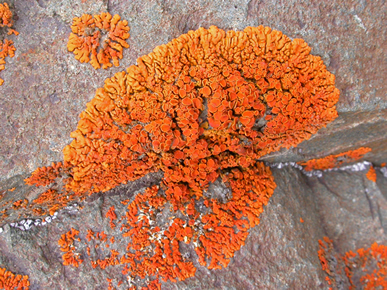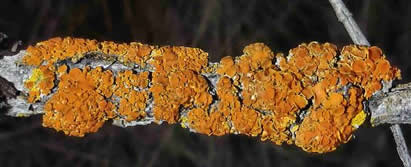|
NATURE NOTES |

Weedy sunburst (Xanthoria parietina), photo by Daryl Thompson
Small Wonders: The Colour Orange
When you sight a brightly coloured sunburst lichen, you can be sure some animal has been in the neighbourhood.
At McQueen Lake Environmental Study Centre, just north of Kamloops, British Columbia, they have an unwritten rule: no peeing in the bushes. Now peeing in the bushes is probably not uppermost in the minds of the thousands of school children who overnight at McQueen Lake each year. At least not when they first arrive. Sooner or later, however, it comes to them that indoor facilities are nowhere to be found at the lake; outhouses are the best they can hope for.
The impact of this realization on media-traumatized young minds is predictable. Confronted with the unhappy prospect of awakening to the call of nature in the dead of night, many of the children develop a sudden and overweening interest in the trunks of Douglas-fir trees growing outside their cabin doors. So, at any rate, say the lichens colonizing the bases of those tree trunks.
The lichens in question are members of the Teloschistales, a group known far and wide for its splendid splashes of orange thalli. As a rule, these lichens are restricted to nutrient-rich surfaces. Look for them on the tines of old antlers, the knobs of old bones, the summits of bird rocks and the branches of apple trees. One surface they tend not to colonize, however, is the nutrient-poor branches of conifers. This is why the Douglas-firs growing outside the sleeping cabins at McQueen Lake are so eye-catching; for at their bases growing heartily, glowing cheerfully, are no fewer than three different species of teloschistalean lichens! The presence here of these lichens tells us that some extraneous source of nutrient enrichment must be involved--in this case, almost certainly urine.
Prominent among the Teloschistales is the genus Xanthoria, alias the sunburst lichens. With 15 species reported from North America, and 13 from Canada, the sunbursts, like many other cryptograms, are familiar to almost everyone, but actually known by almost no one. True to form, they grow wherever nitrogen or calcium occurs in abundance: barnyard trees, seaside rocks, and, not least, the Rocky Mountains. With increases in acidity, however, they become much less abundant, though seldom do they disappear altogether.

Elegant sunburst (Xanthoria elegans), photo by Daryl Thompson
Any localized patch of enrichment will do, no matter how small or how remote. Crow roosts, heronries, chickadee perches, pack rat dens, favourite branches of squirrels or owls--all of these lounging sites sooner or later provide habitat for sunburst lichens. Humankind is surely one of the world's most adept concentrators and relocators of nutrients. Following in our dusty footprints, many a sunburst has expanded its global range during centuries past. Some, like the maritime sunburst (Xanthoria parietina) continue to do so this very day. Only recently has this orange, rind-like species--an inveterate colonizer of ornamental trees and shrubs--found its way (via commercial horticulture operations?) to the west coast of North America.
But I would not leave you with the impression that the activities of humankind have always benefitted the sunbursts. Our tendency to generate acid rain, for example, has in the past led to local extirpations of these and many other lichens. Happily, clean air legislation seems now to be reversing this trend in many parts of the industrialized world.
Another special friend of the sunbursts is poo. Whether in the form of bird guano or as liquid manure being spread over a farmer's field, poo is God's gift to these lichens. In technical jargon, the operative word here is 'coprophily', that is, a taste for details usually not discussed in polite company.
Recently the British, inimitable as always, proposed to inject a little colour into their otherwise drab English suburbs. This they intended to do by encouraging sunburst lichens to colonize their roadside bus shelters. The only catch was, in order to do so, they initially had to plaster said shelters with a slurry of cow pies! I'm not sure if the idea ever caught on.
Other uses of these lichens also have come about as a result of their bright colouration. Thus, in William Shakespeare's day, the sunbursts were occasionally prescribed as a cure for jaundice--apparently a classic instance of homeopathic medicine, which holds that the best way to treat a disease is to fight fire with fire, or, in this case, colour with colour. Nor has the brilliance of the sunbursts failed to catch the eye of weavers and dyers woldwide. In this case, until very recently, what the weavers and dyers saw was decidedly not what they got: for brown or, at best, a languid yellow was all the colour they managed to wrestle from these lichens.

Pincushion sunburst (Xanthoria polycarpa), photo by Curtis Bjork
Then along came Judy Waldner McGrath (Dyes from Lichens and Plants, Van Nostrand Reinhold Ltd., Toronto), who showed the world that the sunbursts also can be coaxed to yield a full complement of other colours, including oranges, pinks, greens and even blues!. Especially intriguing is McGrath's technique for achieving blue, a process involving exposure to bright sunlight. I say intriguing because parietin, the pigment which colours sunbursts orange in the first place, likewise intensifies under sunlight. In fact, intensifying under sunlight appears to be one of the primary functions of this cortical pigment.
A natural form of sunscreen, parietin serves to protect the lichen's sensitive algal partner from exposure to ultraviolet light. The stronger the solar irradiance, the denser the pigment. When growing in shady woods, however, most sunbursts have little need of sun block, and so here they often tend to be more yellowish than orange. Parietin appears to perform at least one more function: its indifferent flavour guards the slow-growing sunbursts against slugs and other herbivores that might otherwise elect to graze them for a living.
For the naturalist, the primary 'value' of sunburst lichens must surely lie in their usefulness as clues for reading the natural world. Students of sea birds, for example, are forever checking Canada's rocky coastlines for the colour orange--a sure sign that sea birds are nesting nearby. Farther inland, a burst of sunburst over the entrance of some outcrop crack or cranny might signal the presence of a coyote den. And even in our far boreal forests, where normally these lichens are sparse, the presence of a sunburst lichen over the branch of a spruce or balsam fir provides strong evidence that some creature has passed this way.
With me, it is an article of faith that the sunburst lichens, under the right conditions, mean animal sign, no less than tracks in the snow. True enough the sign will likely date from some earlier season: usually a couple of years must pass before a colony of sunbursts establishes over a newly laid pocket of dung. By then, or course, the trail will have gone cold, and so possibly will its maker. If, however, the maker should be one of those animals that tends to dwell at the same address year after year, as pack rats do, and as eagles and osprey often do, then who can say: your quarry may at this very moment be glaring down at you.
Such is the way of the sunbursts: providing silent testimony to the comings and goings of a hundred different creatures with which we share this planet. It's all in the colour orange.
Access more of Trevor's writings.
First printed in Nature Canada magazine, in August 2000.
Permission for reprinting in E-Flora BC provided by Trevor Goward.
Please cite these pages as:
Griffith, Hugh, 2006. Ask an Usnea . In: Klinkenberg, Brian (Editor). 2006. E-Flora BC: Electronic Atlas of the Flora of British Columbia. [www.eflora.bc.ca]. Lab for Advanced Spatial Analysis, Department of Geography, University of British Columbia, Vancouver.
E-Flora BC: An initiative of the Spatial Data Lab, Department of Geography UBC, and the UBC Herbarium.
© Copyright 2023 E-Flora BC.